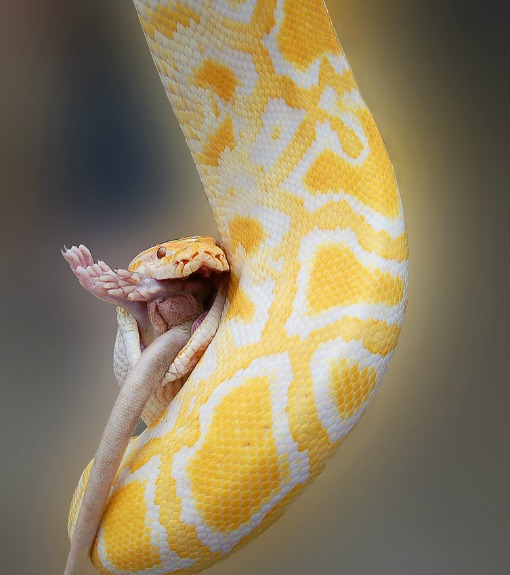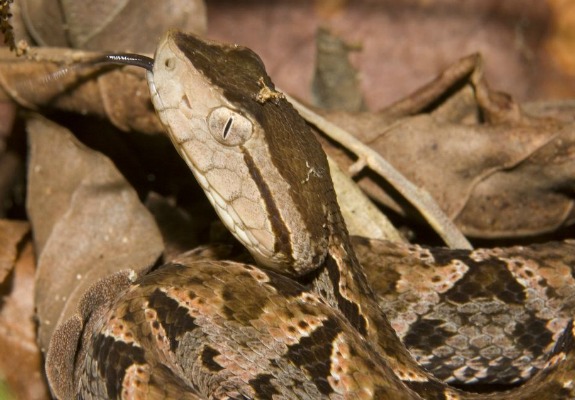Snakes: The Good, the Bad and the Deadly
With venom so potent it can kill a person in 30 minutes, the black mamba is a snake to avoid—while others are worth learning about before you cast judgment
The reticulated python of Southeast Asia is among the world’s two largest snake species (the green anaconda is equally bulky). The “retic” has killed humans before but is arguably more beautiful than it is dangerous. Photo courtesy of Flickr user Global Herper.
Where would we be without snakes? Rodent populations might boom, the native bird assemblage of Guam would probably remain mostly intact today and 100,000 people every year would not die of venomous bites. As we can see, snakes bring both good and bad to the world we share with them. But mostly, these reptiles have been cast in the role of evil.
It’s easy to see why, if we just take a glance at the scariest of the lot—the venomous snakes. Indeed, it might take a very persuasive herpetologist on field sabbatical in Ecuador to convince the locals that the pit viper of his thesis focus is anything but a device of the devil. Throughout the New World tropics, roughly 2,000 people die every year from the bite of the pit viper (Bothrops atrox), known also as the fer-de-lance. Its close cousin, B. asper, goes by the same common names and is comparably devastating and said to be so aggressive it will chase people, bent on sharing some of its powerful venom. And in Africa, the black mamba (Dendroaspis polylepis) seems so wicked it’s absurd: It is the fastest snake in the world and can slither more swiftly than the average city cyclist pedals to work; it is the second-longest venomous snake, growing to 14 feet; it may strike a single victim repeatedly like a psycho with a butcher knife; its venom is so potent it can kill a horse—and a person in just 30 minutes; and, in bite victims who go untreated, the mortality rate is—get this—100 percent. In other words, nobody—that’s nobody—on a trek in the wilderness of tropical Africa, hours from the nearest doctor and without antivenin, survives the bite of the black mamba. As locals say, this snake delivers the “kiss of death.”
Stories of such creatures can leave indelible impressions on the tender minds of men—so indelible that no matter how plain and obvious it is that the harmless gopher snake—or king snake, or rat snake—is a peaceful friend of society that wants little more than to eat a rat (a job that somebody’s got to do, and how grateful we should be that snakes have volunteered), many people still call snake control and removal experts when one appears on their property. Forgive them, Mother Nature, for they know not what they do. Now, whether you love them or hate them, here are a few iconic species to watch for when traveling, from those wickedly venomous to those worth learning more about before you cast your judgment.

Eating rodents is a job someone on this earth has to do, and we should be glad it’s not us. This Burmese python has mostly downed a rat. Photo courtesy of Flickr user Orbital Joe.
Reticulated python (Python reticulatus). Probably the longest snake in the world (if not the heaviest), the reticulated python of Southeast Asia is also an occasional man-eater and a popular pet. (Go figure that one. I’ll stick with my yellow Lab.) Recently, a 25-footer weighing 350 pounds was named the largest snake in captivity—but just how big the largest “retic” ever to have lived might never be known. In 2003, one snake was reported to be 49 feet long and weigh more than 900 pounds. Only when journalist John Aglionby of The Guardian made a trip to see and measure the creature, being kept in a cage in a village in Java, was its real size revealed: 23 feet. Why should we believe an English journalist and not the keeper of the snake, you ask? Come on. Forty-nine feet? Anyway, read Aglionby’s article, which explains the difficulty in measuring large, coiled-up snakes. Worthy to note when discussing the biggest snakes is that between 1997 and 2002, the New York-based Wildlife Conservation Society offered a $50,000 reward to anyone who could produce a 30-foot snake. The prize was never collected.
Ashe’s spitting cobra (Naja ashei). And you thought camels were nasty for spitting in strangers’ faces (they’re actually belching up their cud). Well, the spitting cobra doesn’t just spit; it spits venom. And since the venom is harmless to intact skin, the mean evolutionary tactic behind this nasty habit seems to be, precisely, to hit the victim in the eye, which can cause permanent blindness. Ashe’s spitting cobra is the largest of the dozen or so spitting cobra species, which live in Africa and Asia. N. ashei, first named only in 2007, reaches nine feet in length, has been seen eating five-foot-long puff adders (another deadly venomous snake) and, like all the spitting cobras, can also inject venom by biting. And while we’re discussing cobras, the king cobra (Ophiophagus hannah) can grow to twice the length of the Ashe’s spitting cobra and may administer, in one bite, two-tenths of an ounce of venom to its unfortunate victim—enough to kill an elephant. The species acts aggressively when cornered or when guarding a nest, in which the females lay their eggs, but does not commonly attack humans.
Green anaconda (Eunectes murinus). It is the biggest of the boas and perhaps the bulkiest of all snakes, but the South American green anaconda’s pop culture reputation as a killer may be entirely undeserved. The snake, which gives live birth to 20-inch babies and can reportedly grow to 28 feet and 280 pounds (according to the San Diego Zoo), is relatively sluggish and does not, with any regularity, attack humans.Yet people hate the creatures. Just check out the comments following this blog post about a pregnant anaconda killed by South American villagers. The author of the post questions why the animal was killed. Scores of readers responded like raving idiots at a public hanging. One argued that with 70 baby snakes inside her, the big snake was a population bomb about to go off and would have left the village crawling with hungry anacondas. And another reader said, “e don t need snakes on this world.they are dangerous. i hate the snakes it s the animal of the devil…” Well spoken. Thank you. Next! “hat thing could kill a horse.” No, it probably couldn’t. Next! “How could it possibly have been pregnant? It’s a SNAKE, snakes are REPTILES, and reptiles LAY EGGS!!!” Obviously not a herpetologist. Next! “nake’s aren’t nice animals…there more like monsters who just wanna eat.” Brilliant. Next! “Either you eat the Anaconda, or the Anaconda eats YOU !” All right, all right! Order! In fact, there is no documented case of an anaconda killing a human.
Beaked sea snake (Enhydrina schistosa). Though the Australian inland taipan tops the list of the world’s most venomous snakes, the beaked sea snake isn’t far behind. Rated as the world’s sixth most venomous snake, it is considered the most dangerous sea snake. Its fangs may measure just four millimeters, and surfers and divers wearing wetsuits may be protected, though just barely, from this animal’s bite. Yet nine of every ten people killed by sea snakes are killed by the beaked sea snake, which is said to be easily provoked and very aggressive. It inhabits shallow, murky waters in Australia and much of the Indian Ocean, often among mangrove roots. Wading fishermen are frequent victims.
Santa Catalina Island rattlesnake (Crotalus catalinesis). If the flared hood of a cobra is the icon of danger in the heat of Africa and Asia, then the sound of a rattlesnake giving its warning might be that of the American desert. Which makes the rattlesnake without a rattle a riddle of evolution—though scientists have supposed that its rattleless tail may be a result of evolving on an island mostly absent of other creatures to communicate with. Otherwise, the Santa Catalina Island rattlesnake is a rattlesnake in every way—from head almost to tail. It is a dwarf among rattlesnakes, however, reaching a maximum size of just 28 inches long. It is also endemic to (that is, entirely limited to) the single Sea of Cortez island on which it lives, and—with just 100 square kilometers to call its own—the species is critically endangered. Predation by feral cats is a considerable threat.
Sobering facts about snakebites: In 2011, the BBC reported that snakes bite as many as 5.5 million people every year, killing at least 100,000. In India alone, the article stated, a million people may suffer snakebites every year. The Indian cobra, Russell’s viper, saw-scaled viper and common krait are the main perpetrators in India, while the king cobra tends often to be wrongly blamed. In sub-Saharan Africa, carpet vipers, black mambas, puff adders and boomslangs are snakes to be feared. In Australia, the snake blacklist is long and frightening, while in Europe vipers are the main culprit, and in North America, rattlesnakes. What to do if bitten by a snake? Antivenin is said to be the only reliable treatment, unfortunately. According to the 2011 revision of Where There Is No Doctor: A Village Health Care Handbook, the wound of a snakebite victim should be firmly wrapped in a bandage before the person is carried on a makeshift stretcher to the nearest doctor. “If you can, also take the snake,” the authors advise, as identifying the needed antivenin can otherwise be difficult. And things not to do after receiving a snakebite? Cutting the flesh near the wound, applying ice, trying to suck the venom out of the bite and having a beer (as alcohol can reportedly make symptoms worse).
/https://tf-cmsv2-smithsonianmag-media.s3.amazonaws.com/accounts/headshot/Off-Road-alastair-bland-240.jpg)


/https://tf-cmsv2-smithsonianmag-media.s3.amazonaws.com/accounts/headshot/Off-Road-alastair-bland-240.jpg)